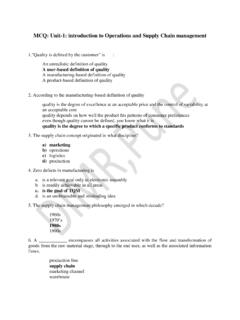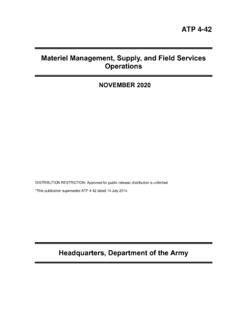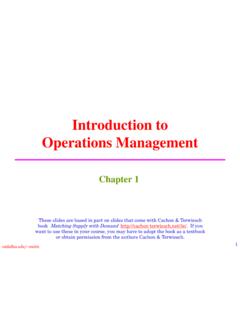Transcription of UNIT - I INTRODUCTION TO PRODUCTION AND …
1 DBA 1651 PRODUCTION MANAGEMENT. unit - I NOTES. INTRODUCTION TO PRODUCTION AND. OPERATION MANAGEMENT. INTRODUCTION Learning objectives System Business System PRODUCTION System PRODUCTION and operations Managements History of operations Management Types of operation system Flow Shop PRODUCTION PRODUCTION PRODUCTION Job Shop Project PRODUCTION PRODUCTION activities and communication link Computer Integrated Manufacture ring (CIM). CIM sub systems Functional Areas of CIM. Computer aided PRODUCTION planning Computer aided process planning Conceptual frame work of CIM. Group Technology Definition History of GT. Advantages of GT. Organizational Suitability for GT. Group technology in CIM. Global supply Chain Global Complexities How to transform into Global supply Chain 1 Anna University Chennai DBA 1651 PRODUCTION MANAGEMENT. NOTES unit - I. INTRODUCTION TO PRODUCTION AND. OPERATION MANAGEMENT. INTRODUCTION . This unit starts with a definition of a system.
2 In this unit PRODUCTION system and its objectives are explained along with the components of a system. The history of operations management is portrayed. The various functions of PRODUCTION system and their interlinking are explained through a flow chart. The components of computer, integrated manufacturing and their purpose are dealt. Finally, the recent trend in the operations , namely, Global supply Chain is introduced in this unit . LEARNING OBJECTIVES. To know the importance of the PRODUCTION system in an organization. To understand the link between various activities of the PRODUCTION system. To comprehend the history of operations management. To understand the components of computer integrated manufacturing SYSTEM. It consists of elements or components. The elements or components are interlinked together to achieve the objective for which it exists. Eg: human body, educational institutions, business organizations.
3 Components of a system: The input, processing, output and control of a system are called the components of a system. Anna University Chennai 2. DBA 1651 PRODUCTION MANAGEMENT. Figure - Components of a system NOTES. Input Output Processing Feedback Control Control: There are two types of control, namely Proactive Control and Reactive Control. Proactive Control: When an operation is carried out on a product in a workstation, the quality inspector goes to the workstation and inspects the product. When the samples that he has taken for the inspection are not confirming to the quality, he stops the machine and identifies the reason for the deviation and corrects the problem, so that the produced product thereafter conform to the specifications. This type of control prevents any major quality setback after the PRODUCTION . This is an example for proactive control. Reactive Control: In a planning period, usually the quality target is fixed.
4 Suppose, an organization feels to fix 5% defective is safe in the targeted PRODUCTION quantity and assumes that at the end of the planning period it finds that the defective output exceeds the targeted defective products. Then, it has to find out the reason for the deviations, namely, whether the problem is due to the method of doing the work or the resources used in the process. Then the planner uses this knowledge to prevent any problem in the future. Thus a Reactive Control is a post morterm case. Business System: The business organization is classified into different subsystems based on the functions like marketing, PRODUCTION /operation, finance and human resource etc. 3 Anna University Chennai DBA 1651 PRODUCTION MANAGEMENT. Figure Business System NOTES. Marketing Finance Human Resource PRODUCTION /Operation Each subsystem will have more sub subsystems. PRODUCTION / Operation System Figure PRODUCTION / Operation System Input Transformation Output Objectives Process 1.
5 To produce the required quantity. Capital Man Power Goods 2. To achieve the required quantity. Material 3. To meet the delivery time. Information Services 4. Economical way of doing operations Management Operation system is either manufacturing sector or service sector. The input requirements are shown in The transformation process, in which part of the value addition takes place to get the required quantity of the product or services with the targeted quality within the specified time period, is carried out in a most economical way. Operation Management Plan coordinates and controls all the activities in the operation system to achieve the stated objectives. Thus (the activities listed in the diagram) the operations Management activities, ensure the objective of quantity, quality, delivery time and economical way of doing work. The communication link between the various activities are shown in the Each activity is dealt in detail in different sections of this material.
6 This figure ( ) will be very much appreciated after getting a clear understanding of all the activities. Anna University Chennai 4. DBA 1651 PRODUCTION MANAGEMENT. What is operation management (OM)? NOTES. Operation Management is a way or means through which the listed objectives of an operating system is achieved. There is always a confusion between the word OM. & PM ( PRODUCTION Management). It is accepted norm that OM includes techniques which are enabling the achievement of operational objectives in an operation system. The operation system includes both manufacturing sector as well as service sector, but when you use the word PM, you should be careful to note that it refers to the manufacturing sector but not the service sector. Suppose, you are designing a layout for the hospital you should say that you are applying operations Management Technique not the PRODUCTION Management Technique. When you design a layout for a manufacturing sector you can say that you are applying PRODUCTION Technique or Operation Technique or vice versa.
7 From, the above discussion we can come to a conclusion that PRODUCTION management is a subset of operations Management. Review questions . 1. What are the components of a system? 2. What are the differences between the PRODUCTION Management and the operations Management? 3. List the objectives to be fulfilled by an Operation System. HISTORY OF OM. Table History of OM. Year /. Period of Concept/Tools and System Used Developers/. Concept Originators (14-16) Evolution of PRODUCTION system Century 18th New Technology for PRODUCTION Process Adam Smith and Century Management harles Babbage 1895 Scientific Management Principles (Work Study) Taylor Motion Study for Psychological Factors Frank & Lillian Activity Scheduling Chart Gilbreth Henry Gantt 1935 Hawthrone Studies of Worker Motivation Elton Mayo 1950's Operation Research for Decision Making Long Many Researcher term Medium term, Short term decision by 5 Anna University Chennai DBA 1651 PRODUCTION MANAGEMENT.
8 Critical Path Method (CPM), Program Evaluation NOTES and Technique (PERT), Waiting-Line Theory 1970's Computers for Inventory Control Material IBM, Joseph Resource Planning (MRP) Orlicky, Oliver Wieght 1980's Just In Time (JIT), Total Quality Control (TQC) Toyota Kanban System, CAD/CAM, Computer Integrated Manufacturing (CIM) Flexible Manufacturing System (FMS). 1990's Quality Asqc( ). IOS. Management (TQM), Concurrent (CIM), (England), Engineering, Value Engineering Michael Hammer 2. Business Process Engineering Oracle, SAP. 3. supply Chain Management (Germany). 2000's Logistics, Enterprise Resource Planning (ERP), E-Commerce, E-Business Review questions - 1. What is the contribution of GANTT? 2. Who is the father of Scientific Management? TYPES OF OPERATION SYSTEM. The type of Operation System to be adopted should be known to the people, and then only you may choose the system based on the nature of the product that you are going to manufacture.
9 The types of operation system are classified based on the following criteria. Product flow pattern in conversion system Output of the product Specification of the output Figure - Types of Operation System PRODUCTION Flow Pattern Output of the product Specification of the output Customized Standard Flow shop Job shop Flow shop Continuous Batch Mass Goods PRODUCTION PRODUCTION PRODUCTION Services Anna University Chennai 6. DBA 1651 PRODUCTION MANAGEMENT. The characteristics of the Operation System based on the product flow pattern: NOTES. Flow Shop In this kind of PRODUCTION , the productive resources are arranged according to the sequence of operation required by the product design. Assume that you are engaged in the ready to wear clothing, if you want to adopt the flow shop PRODUCTION , then the productive resources are kept according to the sequence of operations required by the product like Cutting Joining by sewing Adding, buttons, zippers etc Quality checking Packaging Mostly Flow shop PRODUCTION are adopted when there is untapped market for the product, customers are price sensitive and more competition in the market.
10 Flow shop PRODUCTION as shown in the figure is further divided into Continuous PRODUCTION , Mass PRODUCTION and Batch PRODUCTION . Continuous PRODUCTION The industries involved in the following activities are classified as Continuous PRODUCTION Oil refining. Fertilizer PRODUCTION . Chemical processing etc. In this type of PRODUCTION the product flows continuously without much interruption. This type of PRODUCTION lacks in flexibility. Mass PRODUCTION The industries involved in the following activities are classified as the Mass PRODUCTION Industries: Auto Manufacturing TV Manufacturing Cigarettes This kind of flow shop produces the same type of output, it has little flexibility compared to Continuous PRODUCTION . Batch PRODUCTION The industries involved in the following activities are classified as the Intermittent PRODUCTION . Shoe manufacturing Bottling plant Cloth manufacturing 7 Anna University Chennai DBA 1651 PRODUCTION MANAGEMENT.






